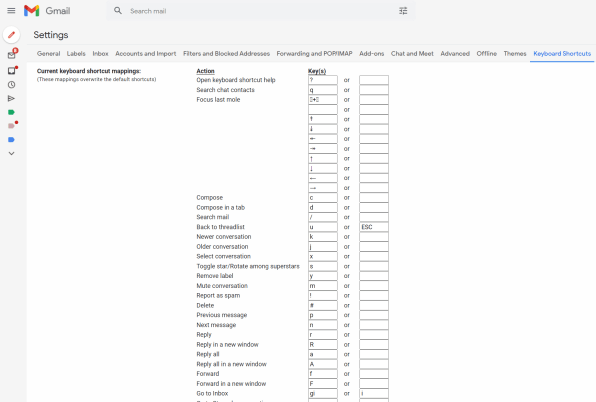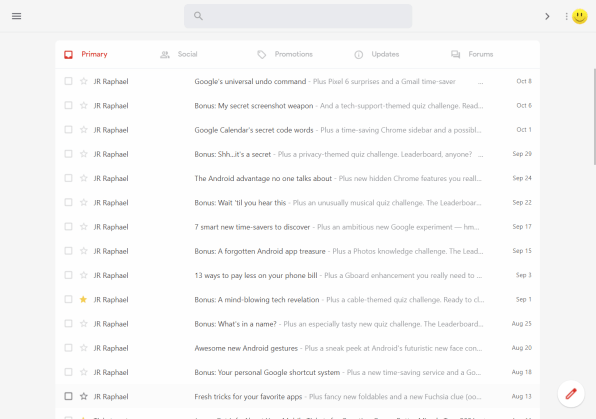These 4 Gmail speed boosters let you fly through your inbox
In the life of a Very Busy Person, every saved second can seem like an eternity.
It may sound silly, but if you find yourself running out of minutes in the day as often as I do, you probably know what I mean. Shaving seconds off time-consuming tasks can stack up fast, and there are few places more ripe for such step-slashing sorcery than your dusty old Gmail inbox.
And here’s a little secret: With a handful of smart adjustments to your emailing habits, you can reclaim not only seconds but entire minutes of your day that are typically devoted to mind-numbing, meaningless email-oriented tasks. And you don’t even need a $30-a-month add-on to do it.
Follow this guide to streamlining standard Gmail processes, and get ready to marvel at how quickly all of those saved seconds add up.
Gmail speed booster #1: Basic keyboard shortcuts
The first and most effective Gmail efficiency enhancer is without a doubt a wholehearted embracing of keyboard shortcuts. That’s one of the key components of Superhuman, in fact—the aforementioned $30-a-month add-on that some tech power players swear by.
The truth, though, is that the same sort of superpower can just as easily be achieved without that supersized price tag. It’s mostly just a matter of reminding yourself about some choice out-of-sight commands, and then training yourself to rely on them.
And you know what? Gmail’s own keyboard shortcut system is absolutely packed with potential. When you’re composing a message, for instance—be it a new email or a reply to an existing thread:
From your inbox or any other message list, meanwhile:
And while viewing any individual message thread:
Finally, from any message list within the Gmail website:
Now, actually getting yourself in the habit of using these shortcuts is a whole other challenge. The trick, I’ve found, is to focus on one or two new shortcuts at a time and really internalize them. Once you’ve started relying on them without any thought or effort, move on to another one or two shortcuts and focus entirely on those. Otherwise, you’re bound to overwhelm your brain and never get into the groove of using them.
And note that before any of these built-in Gmail shortcuts will work, you’ll need to enable the off-by-default “Keyboard shortcuts” setting within the Gmail desktop website, if you haven’t already. To find that, click the gear-shaped settings icon in the site’s upper-right corner, click “See all settings,” then scroll down until you see the line labeled “Keyboard shortcuts.” Shift its setting into the on position and be sure to scroll all the way to the bottom of the screen to click the Save Changes button when you’re done.
Gmail speed booster #2: Custom keyboard shortcuts
Gmail’s built-in shortcuts are sublime, but you don’t have to stop there.
First, Gmail has a tucked-away option that’ll let you customize your own native keyboard shortcuts and make them even more well-suited to your specific needs and preferences. To find it:
And would you look at that? You’ve just given yourself a complete list of Gmail’s keyboard shortcuts and the opportunity to change or expand what specific key sequences activate them.

A few changes I like to make in this area include adding in ESC for the “Back to threadlist” shortcut and adding in I for the “Go to Inbox” shortcut—both of which simplify the associated commands and make them faster and more intuitive to activate—and then adding in $ for the “Snooze” command, just because that’s much more sensible and easy to remember than the random-seeming B default Google for some reason selected for that.
Don’t run off yet, though. That’s still just the beginning of our Gmail recalibration journey.
Gmail speed booster #3: Smart shortcut supplements
Gmail’s got plenty of exceptional add-ons that connect your inbox to external services and cut out back-and-forth tab flipping. Here, I want to focus on one specific supplement that adds valuable time-saving shortcuts directly into the Gmail interface.
It’s called Simplify, and it’s the passion project of a former Gmail design lead and the guy who created Google’s short-lived but much beloved Inbox email client.

Simplify brings lots of wonderful enhancements to the Gmail website and reimagines the entire interface into something cleaner, simpler, and easier to use than what Google gives you by default. But specific to our conversation today, it also gives you a bunch of clever new keyboard shortcuts that make getting around Gmail meaningfully faster.
For instance, with the Simplify extension installed:
That’s all just scratching the surface of how Simplify can improve your inbox and increase your email efficiency. The program costs a mere two bucks a month, paid annually, and that single payment allows you to use the extension with up to ten different Gmail addresses, in case you have multiple accounts.
Gmail speed booster #4: Smart settings adjustments
Last but not least in our Gmail speed boosting collection are a few fast changes to out-of-the-way Gmail settings. These can make a world of difference in your email experience and the speed at which you make it through messages.
Specifically:

Implement all of these speed boosters and get yourself in the habit of taking advantage of what they can accomplish, and before you know it, being a Very Busy Person might be just a little less overwhelming than it used to be.
Hungry for even more tasty time-savers? Check out my free Android Shortcut Supercourse to learn tons of useful ways to make your smartphone smarter.
(21)



